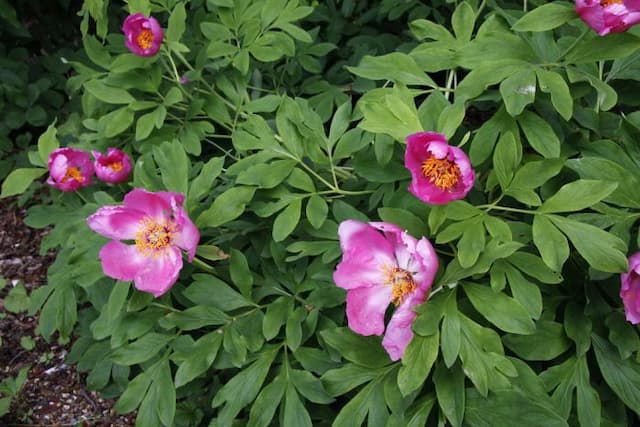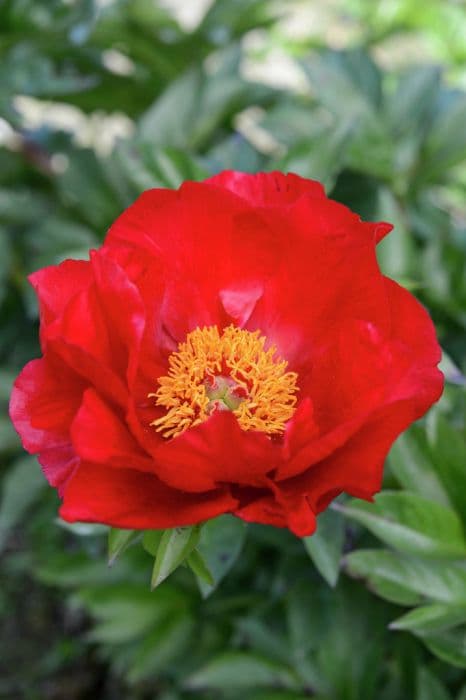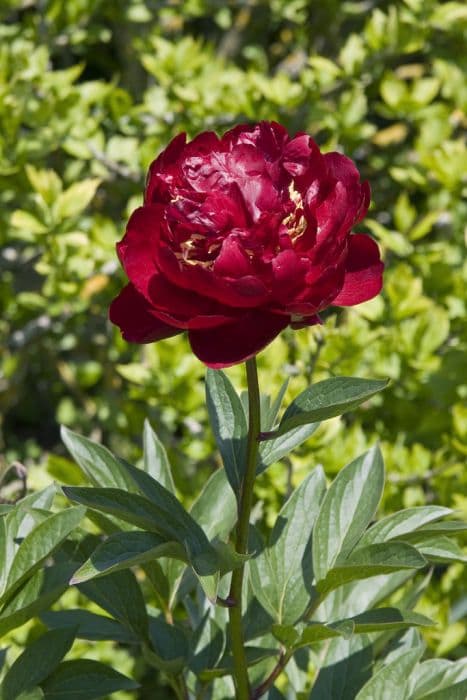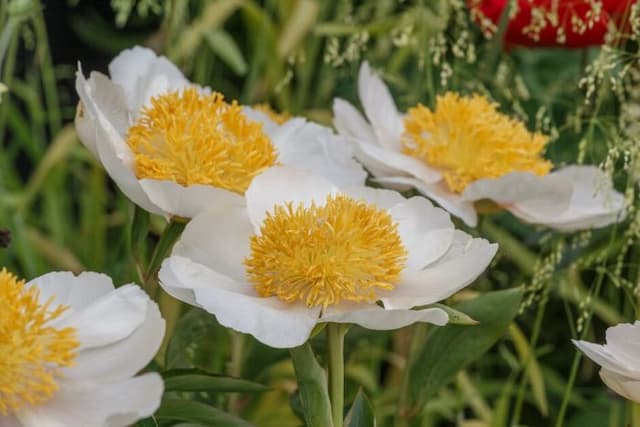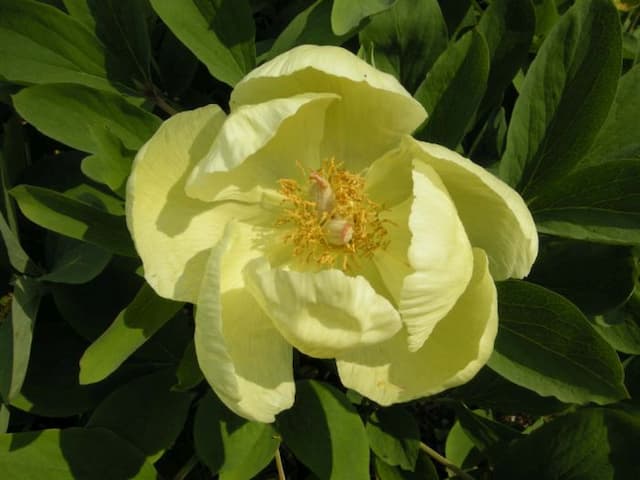Peony Paeonia lactiflora 'Sorbet'

ABOUT
The Paeonia lactiflora 'Sorbet' is commonly known as the peony 'Sorbet', and it's recognized for its strikingly beautiful flowers. The blooms are unique, with a multi-layered appearance, resembling a scoop of sorbet. Each flower is made up of different layers of petals which may include shades of pink and cream. The outer petals tend to be broad and lighter in color, often a soft pink or blush, cradling the inner petals that can be a more intense pink or even a creamy white with hints of darker pink at the base, giving it a delightful depth and contrast that is reminiscent of the sweet treat it's named after. The peony 'Sorbet' has a lush, full appearance, with glossy green leaves that provide a perfect backdrop for the voluminous and showy flowers. The leaves are divided into leaflets, which have a rounded or slightly pointed shape, and their edges can be smooth or subtly serrated. The foliage can form a bushy, dense mound that showcases the blooms elegantly atop sturdy stems. During its blooming season, the peony 'Sorbet' can become the centerpiece of any garden, bringing not only visual delight but also a soft, pleasing fragrance that enhances its overall appeal. This perennial is a favorite among gardeners and flower enthusiasts for its striking visual appeal and ability to add classic charm to any landscape setting.
About this plant
 Names
NamesFamily
Paeoniaceae
Synonyms
Chinese Peony, Common Garden Peony, White Peony
Common names
Paeonia lactiflora 'Sorbet'.
 Toxicity
ToxicityTo humans
Peonies, including Paeonia lactiflora 'Sorbet', are not considered highly toxic to humans. However, they can cause mild gastrointestinal upset if ingested in large quantities. Symptoms may include nausea, vomiting, and diarrhea. The plant parts most likely to cause discomfort are the roots and seeds, whereas the flowers and foliage are less likely to be harmful. It is generally advised to avoid ingesting any part of peonies.
To pets
Peonies, including Paeonia lactiflora 'Sorbet', can be toxic to pets, particularly cats and dogs, if ingested. The primary symptoms of peony poisoning in pets may include vomiting, diarrhea, and drooling. In rare cases, more severe symptoms such as depression and tremors could occur if a significant amount is consumed. It is important to prevent pets from chewing on any part of peonies, especially the roots and seeds, to avoid the possibility of toxic effects.
 Characteristics
CharacteristicsLife cycle
Perennials
Foliage type
Deciduous
Color of leaves
Green
Flower color
Mixed
Height
2-3 feet (0.6-0.9 meters)
Spread
2-3 feet (0.6-0.9 meters)
Plant type
Herb
Hardiness zones
3-8
Native area
Asia
Benefits
 General Benefits
General Benefits- Ornamental Value: The Paeonia lactiflora 'Sorbet', commonly known as Peony 'Sorbet', has lush, double flowers with a unique two-tone appearance that makes it a striking addition to any garden.
- Long Bloom Time: Peonies typically have a long flowering period during late spring to early summer, providing a lasting display of color.
- Perennial Growth: As a perennial plant, once established, it will return year after year, offering a long-term presence in the garden.
- Attracts Pollinators: The large blooms are attractive to butterflies, bees, and other beneficial pollinators, which are essential for a healthy garden ecosystem.
- Cut Flower Use: Peony 'Sorbet' makes excellent cut flowers with a long vase life, perfect for floral arrangements and bouquets.
- Drought Tolerance: Once established, peonies can tolerate periods of drought, making them suitable for gardens with lower water availability.
- Cold Hardiness: Peonies are cold hardy and can survive in cold winter climates without significant protection.
- Low Maintenance: This plant requires minimal upkeep once established, with little need for pruning or complex care.
- Deer Resistance: Peonies are generally resistant to deer, which makes them a good choice for gardens in areas with high deer populations.
 Medical Properties
Medical Properties- Anti-inflammatory: Paeonia lactiflora has compounds that may reduce inflammation.
- Antioxidant: Contains antioxidants that help in protecting cells from oxidative stress.
- Analgesic: Some components might have pain-relieving properties.
- Immunomodulatory: It may influence the immune system and improve its response.
- Neuroprotective: Has potential effects in protecting nerve cells.
- Cardiovascular health: Can have a positive effect on blood circulation and heart health.
- Antispasmodic: May help in relieving muscle spasms.
- Antitumor: Contains elements that might have activity against tumor cells.
- Hepatoprotective: It may offer some protection to the liver from certain toxins.
 Air-purifying Qualities
Air-purifying QualitiesThis plant is not specifically known for air purifying qualities.
 Other Uses
Other Uses- Peony petals can be crystallized and used as edible decorations on cakes and desserts, providing a touch of elegance and flavor.
- Peonies in bloom can serve as a natural indicator of the start of the fishing season in certain regions, as they often coincide with fish migrations.
- The strong stems of the Peony plant can be used in basket weaving and as a natural support for other climbing plants in the garden.
- Dried Peony petals can be incorporated into potpourri mixes, adding a subtle fragrance and bursts of color to a room.
- Artists might use the Peony's intricate petals and vibrant colors as inspiration for paintings, textile designs, and other creative works.
- Peony flowers can be pressed and included in personal diaries or scrapbooks, serving as mementos for special occasions.
- During special events, Peony flowers can be floated in large bowls of water to create decorative centerpieces.
- The vibrant Peony blooms can be photographed and used for greeting cards, calendars, or as stock images.
- Peony seed pods have a unique architectural form and can be used in dried flower arrangements.
- The contrast between the Peony's lush foliage and its flowers can be used in landscape design to create visual interest and texture in gardens.
Interesting Facts
 Feng Shui
Feng ShuiThe peony is often used in Feng Shui as a symbol of love, romance, and feminine beauty. It is typically placed in the southwest corner of a garden or room to enhance relationship luck and to encourage positive energy, or chi, related to love and marriage.
 Zodiac Sign Compitability
Zodiac Sign CompitabilityThe peony is not used in astrology practice.
 Plant Symbolism
Plant Symbolism- Prosperity: Paeonia lactiflora 'Sorbet', commonly known as the peony, is often considered a symbol of wealth and honor. Having traditionally adorned imperial gardens, peonies are associated with riches and honor in Chinese culture.
- Romance: Peonies are widely regarded as a symbol of romantic love, with their lush and full blooms. They are often used in wedding bouquets to signify a happy marriage.
- Beauty: With their large and layered petals, peonies epitomize the classical notion of beauty. They often represent the ideal of feminine allure and charm.
- Good Fortune: In many cultures, peonies are believed to bring good luck and prosperity, making them a popular choice for festive occasions.
- Compassion: Peonies can symbolize bashfulness or compassion, with the myth of Paeon, a student of Asclepius in Greek mythology, being transformed into a peony flower after showing empathy and compassion.
 Water
WaterPeonies, including the Paeonia lactiflora 'Sorbet', should be watered deeply once a week, providing about one inch of water each time. This equates to roughly 0.6 gallons per square yard if you're watering a garden bed. During the growing season, especially if the weather is dry, make sure the soil around peonies is kept moist but not waterlogged. Increase watering if there are extended periods of drought, but always allow the soil to dry out slightly between watering sessions to prevent root rot. In the fall, reduce watering to help prepare the plants for dormancy.
 Light
LightPeonies like the Paeonia lactiflora 'Sorbet' thrive in full sun to partial shade. They perform best when they receive at least six hours of direct sunlight each day. However, in very warm climates, they benefit from some afternoon shade to prevent the flowers from fading too quickly. Choose a spot that is not shaded by trees or buildings to ensure your peony gets enough light throughout the day.
 Temperature
TemperaturePeonies, including Paeonia lactiflora 'Sorbet', can survive winter temperatures as low as -20°F once they are dormant, but they prefer the growing season to have temperatures ranging between 65°F and 75°F. Peonies require a period of winter chilling, below 40°F for about 400-500 hours, to set buds and bloom properly. They do not perform well in tropical climates where such cooling periods do not occur.
 Pruning
PruningPeonies like Paeonia lactiflora 'Sorbet' should be pruned to remove spent blooms after flowering to maintain plant vigor and appearance. Additionally, in the fall, prune back the foliage to the ground after the first frost to minimize the risk of disease. Pruning in the fall also helps to prep the plant for winter and ensures that the next season's growth is healthy and vibrant.
 Cleaning
CleaningAs needed
 Soil
SoilPeonies like 'Sorbet' thrive in well-draining soil with a neutral to slightly alkaline pH of 6.5 to 7.5. A mix of two-thirds garden soil and one-third compost or well-rotted manure, with a handful of perlite or vermiculite to improve drainage, is ideal for peonies to flourish.
 Repotting
RepottingPeonies such as 'Sorbet' seldom need repotting and prefer to be left undisturbed. If necessary, repot every 10 to 15 years in autumn after the plant becomes too large or shows signs of decreased flowering.
 Humidity & Misting
Humidity & Misting'Sorbet' peonies are not particularly sensitive to humidity levels and can thrive in the typical range provided by average outdoor conditions; high humidity is generally not required for healthy growth.
 Suitable locations
Suitable locationsIndoor
Ensure ample light and cool temperatures for indoor peony growing.
Outdoor
Plant in full sun with well-draining, fertile soil outdoors.
Hardiness zone
3-8 USDA
 Life cycle
Life cycleThe Peony 'Sorbet' begins its life cycle as a tuberous root, which, when planted in the fall, undergoes a period of dormancy during the winter months. With the onset of spring, shoots emerge from the soil, slowly developing into stems with compound leaves, signaling the vegetative growth stage. As the temperatures continue to warm, typically in late spring to early summer, the plant enters the flowering stage, where it produces large, fragrant, pink and white multi-layered blooms that are characteristic of the 'Sorbet' variety. After pollination, which is often facilitated by insects, the flowers may develop into seed pods if seeds are to be produced, completing the reproductive stage. Once the blooming period ends, the foliage continues to photosynthesize and store energy in the roots until autumn when the plant begins to senesce, with leaves yellowing and dying back to the ground. The cycle repeats when the plant reenters dormancy for the winter, conserving its energy in the roots until the next growing season.
 Propogation
PropogationPropogation time
Late fall
Propogation: The Paeonia lactiflora 'Sorbet', commonly known as the Peony 'Sorbet', is typically propagated by dividing the root system. The ideal time for dividing peony tubers is in the fall after the plants have gone dormant, usually around September or October. When dividing, carefully dig up the entire plant, and gently shake off the soil to reveal the tuberous roots. Using a sharp knife, cut the tuber into sections, ensuring that each section has at least 3 to 5 eyes, which are the growth buds for next year's shoots. Replant the divisions promptly, setting them so that the eyes are 1 to 2 inches below the soil surface (2.5 to 5 centimeters), and space them about 2 to 3 feet apart to allow for future growth. After planting, water them thoroughly to settle the soil around the roots.
